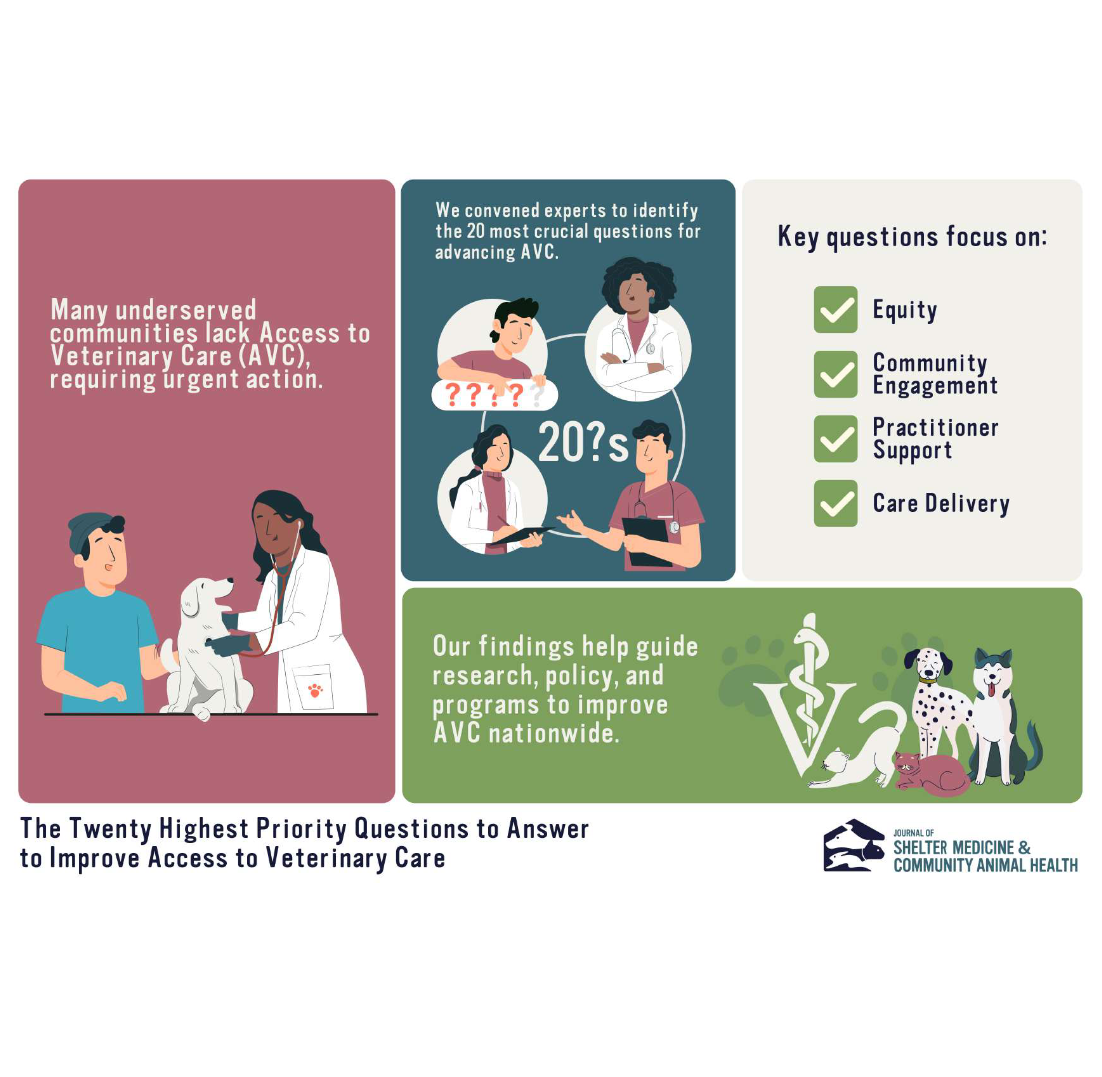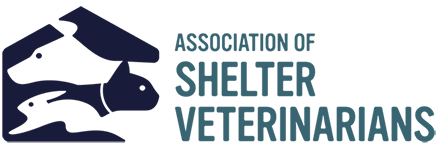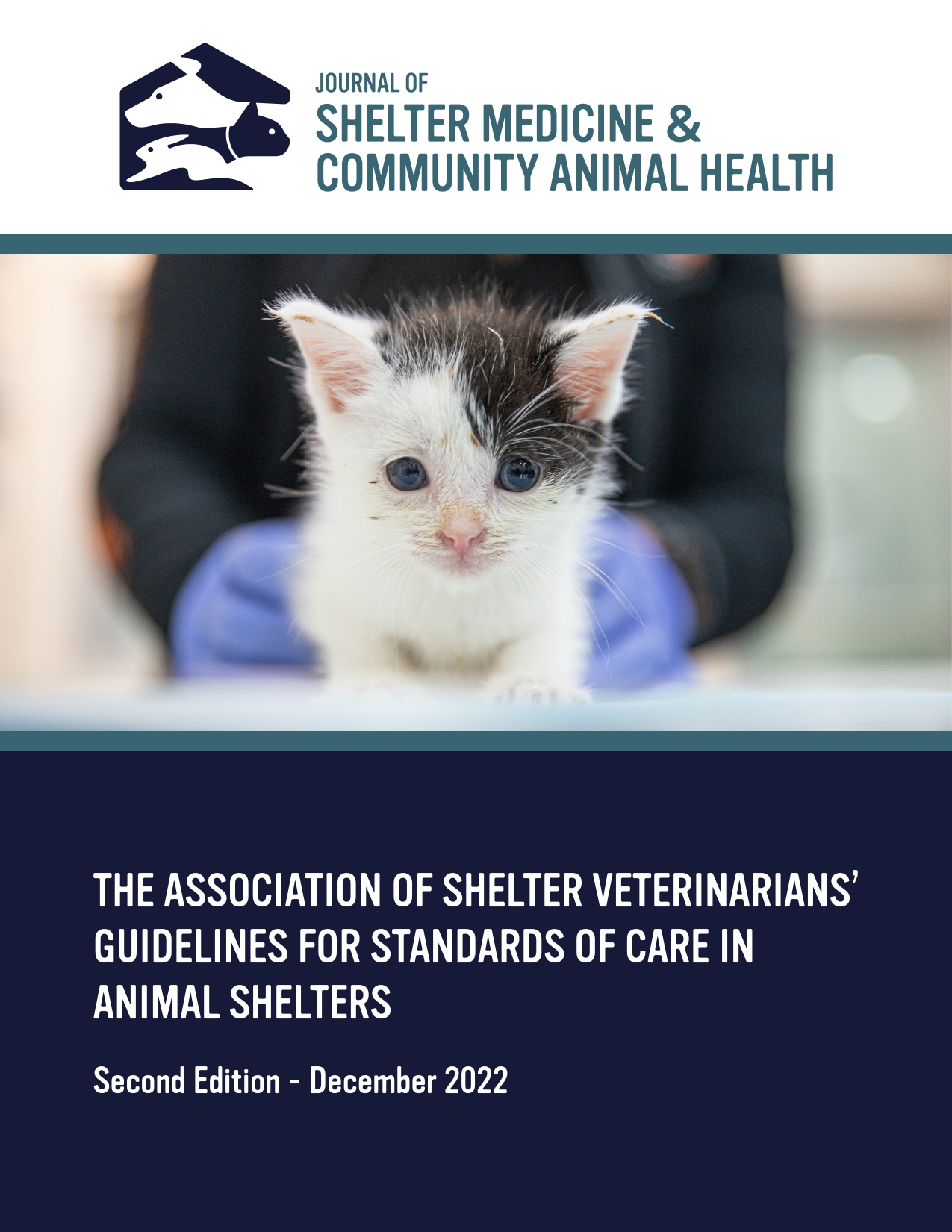The Twenty Highest Priority Questions to Answer to Improve Access to Veterinary Care
DOI:
https://doi.org/10.56771/jsmcah.v4.106Keywords:
priority setting, research agenda, access to veterinary care, animal welfareAbstract
The veterinary and animal welfare fields are tasked to respond to the urgent need for improved access to veterinary care (AVC) for underserved populations across the nation. We conducted an initial survey and an iterative selection of priority questions using a modified Delphi method among a committee of experts in AVC to identify the 20 questions with the greatest potential to inform and advance our crucial work in AVC, if answered. The results of this project produced expansive questions focused on equity, engaging communities and pet owners, supporting practitioners, and delivering care. We then provided a landscape of existing research with the goal of supporting academics, practitioners, and communities in prioritizing their research and program development agendas, ultimately advancing AVC efforts around the country.
Downloads
References
1.
Bir C, Ortez M, Widmar NJO, Wolf CA, Hansen C, Ouedraogo FB. Familiarity and use of veterinary services by US resident dog and cat owners. Animals. 2020;10:1–27. doi: 10.3390/ani10030483
2.
Hawes SM, Hupe TM, Winczewski J, et al. Measuring changes in perceptions of access to pet support care in underserved communities. Front Vet Sci. 2021;8:1–14. doi: 10.3389/fvets.2021.745345
3.
Lem M. Barriers to accessible veterinary care. Can Vet J. 2019;60:891–893.
4.
LaVallee E, Mueller MK, McCobb E. A systematic review of the literature addressing veterinary care for underserved communities. J Appl Anim Welf Sci. 2017;20(4):381–394. doi: 10.1080/10888705.2017.1337515
5.
Kent JL, Mulley C. Riding with dogs in cars: what can it teach us about transport practices and policy? Transp Res Part A. 2017;106:278–287. doi: 10.1016/j.tra.2017.09.014
6.
Morris A, Wu H, Morales C. Barriers to care in veterinary services: lessons learned from low-income pet guardians’ experiences at private clinics and hospitals during COVID-19. Front Vet Sci. 2021;8:1–7. doi: 10.3389/fvets.2021.764753
7.
Hinchcliff AN, Harrison KA. Systematic review of research on barriers to access to veterinary and medical care for deaf and hard of hearing persons. J Vet Med Educ. 2022;49(2):151–163. doi: 10.3138/jvme-2020-0116
8.
Neal SM, Greenberg MJ. Putting access to veterinary care on the map: a veterinary care accessibility index. Front Vet Sci. 2022;9:1–8. doi: 10.3389/fvets.2022.857644
9.
Winkley EG, KuKanich K, Nary D, Fakler J. Accessibility of veterinary hospitals for client mobility-related disabilities. J Am Vet Med Assoc. 2020;256(3):333–339. doi: 10.2460/javma.256.3.333
10.
Lloyd J. Pet Healthcare in the US: Are There Enough Veterinarians? Mars Veterinary Health; 2021. https://www.marsveterinary.com/wp-content/uploads/2022/03/Characterizing%20the%20Need%20-%20DVM%20-%20FINAL_2.24.pdf. Accessed February 20, 2024.
11.
Lloyd J. Pet Healthcare in the U.S.: Another Look at the Veterinarian Workforce. Mars Veterinary Health; 2023. https://www.marsveterinary.com/wp-content/uploads/2023/08/Characterizing-the-Need.pdf. Accessed February 20, 2024.
12.
Arluke A, Rowan AN. Underdogs: Pets, People, and Poverty. The University of Georgia Press; 2020. https://www.jstor.org/stable/j.ctvxkn5fc
13.
White S. Fundamentals of HQHVSN. White S, ed. 2020.Wiley; doi: 10.1002/9781119646006.ch23
14.
Wu H, Bains RS, Morris A, Morales C. Affordability, feasibility, and accessibility: companion animal guardians with (dis)abilities’ access to veterinary medical and behavioral services during COVID-19. Animals. 2021;11(8):2359. doi: 10.3390/ani11082359
15.
Nishi NW, Collier MJ, Morales GI, Watley E. Microaggressions in veterinary communication: what are they? How are they harmful? What can veterinary professionals and educators do? J Am Vet Med Assoc. 2023;262(3):1–6. doi: 10.2460/javma.23.07.0412
16.
Access to Veterinary Care Coalition. Access to Veterinary Care: Barriers, Current Practices, and Public Policy. The University of Tennessee; Knoxville TN; 2018.
17.
HSUS. Keeping Pets for Life. Humane Society of the United States; 2020. https://www.humanesociety.org/issues/keeping-pets-life. Accessed October 2, 2020.
18.
Mueller MK, Chubb S, Wolfus G, McCobb E. Assessment of canine health and preventative care outcomes of a community medicine program. Prev Vet Med. 2018;157(20):44–49. doi: 10.1016/j.prevetmed.2018.05.016
19.
King E, Mueller M, Wolfus G, McCobb E. Assessing service-learning in community-based veterinary medicine as a pedagogical approach to promoting student confidence in addressing access to veterinary care. Front Vet Sci. 2021;8:1–7. doi: 10.3389/fvets.2021.644556
20.
Sutherland WJ, Adams WM, Aronson RB, et al. One hundred questions of importance to the conservation of global biological diversity. Conserv Biol. 2009;23(3):557–567. doi: 10.1111/j.1523-1739.2009.01212.x
21.
Sutherland WJ, Freckleton RP, Godfray HCJ, et al. Identification of 100 fundamental ecological questions. Gibson D, ed. J Ecol. 2013;101(1):58–67. doi: 10.1111/1365-2745.12025
22.
Sutherland WJ, Armstrong–Brown S, Armsworth PR, et al. The identification of 100 ecological questions of high policy relevance in the UK. J Appl Ecol. 2006;43(4):617–627. doi: 10.1111/j.1365-2664.2006.01188.x
23.
Sargeant JM, Brennan ML, O’Connor AM. Levels of evidence, quality assessment, and risk of bias: evaluating the internal validity of primary research. Front Vet Sci. 2022;9:960957. doi: 10.3389/fvets.2022.960957
24.
Brett J, Staniszewska S, Mockford C, et al. Mapping the impact of patient and public involvement on health and social care research: a systematic review. Health Expect. 2014;17(5):637–650. doi: 10.1111/j.1369-7625.2012.00795.x
25.
Panchal AR, Cash RE, Crowe RP, et al. Delphi analysis of science gaps in the 2015 American Heart Association cardiac arrest guidelines. J Am Heart Assoc. 2018;7(13):e008571. doi: 10.1161/JAHA.118.008571
26.
Kobus J, Westner M. Ranking-type delphi studies in IS research: step-by-step guide and analytical extension. In: IADIS International Conference on Information Systems; Vilamoura, Algarve, Portugal; 2016.
27.
Sullivan GM, Artino AR. Analyzing and interpreting data from Likert-type scales. J Grad Med Educ. 2013;5(4):541–542. doi: 10.4300/JGME-5-4-18
28.
Kunz K, Atsas S. Ensuring equitable access to public health care: two steps forward, one step back. Soc Sci J. 2013;50(4):449–460. doi: 10.1016/j.soscij.2013.07.013
29.
Roberts C, Woodsworth J, Carlson K, Reeves T, Epp T. Defining the term ‘underserved’: a scoping review towards a standardized description of inadequate access to veterinary services. Can Vet J. 2023;64(10):941–950.
30.
Pasteur K, Diana A, Yatcilla JK, Barnard S, Croney CC. Access to veterinary care: evaluating working definitions, barriers, and implications for animal welfare. Front Vet Sci. 2024;11:1335410. doi: 10.3389/fvets.2024.1335410
31.
Lundahl L, Powell L, Reinhard CL, Healey E, Watson B. A pilot study examining the experience of veterinary telehealth in an underserved population through a university program integrating veterinary students. Front Vet Sci. 2022;9:1–9. doi: 10.3389/fvets.2022.871928
32.
Poss JE, Everett M. Impact of a bilingual mobile spay/neuter clinic in a U.S./Mexico border city. J Appl Anim Welf Sci. 2006;9(1):71–77. doi: 10.1207/s15327604jaws0901_7
33.
Mattson K. Veterinary medicine may face increasing challenges around language barriers. J Am Vet Med Assoc. 2019;255(10):1083. doi: 10.2460/javma.255.10.1083
34.
Bunke L, Harrison S, Angliss G, Hanselmann R. Establishing a working definition for veterinary care desert. J Am Vet Med Assoc. 2023;262(1):1–8. doi: 10.2460/javma.23.06.0331
35.
Blackwell MJ, O’Reilly A. Access to veterinary care – a national family crisis and case for one health. Adv Small Anim Care. 2023;4(1):145–157. doi: 10.1016/j.yasa.2023.05.003
36.
Garabed R, Overcast M, Behmer V, Bryant E, Heredia K, Jones A. Business Models Used to Improve Access to Veterinary Care. Ohio State University College of Veterinary Medicine, Columbus OH; 2022.
37.
Arrington A, Markarian M. Serving pets in poverty: a new frontier for the animal welfare movement. Sustain Dev Law Policy. 2017;18(1):40–43.
38.
Jenkins JL, Rudd ML. Decolonizing animal welfare through a social justice framework. Front Vet Sci. 2022;8:787555. doi: 10.3389/fvets.2021.787555
39.
Decker Sparks JL, Camacho B, Tedeschi P, Morris KN. Race and ethnicity are not primary determinants in utilizing veterinary services in underserved communities in the United States. J Appl Anim Welf Sci. 2018;21(2):120–129. doi: 10.1080/10888705.2017.1378578
40.
Cammisa H, Hill S. Payment options: an analysis of 6 years of payment plan data and potential implications for for-profit clinics, non-profit veterinary providers, and funders to access to care initiatives. Frontiers. 2022;9:1–9. doi: 10.3389/fvets.2022.895532
41.
Hohenhaus AE. Improving access to advanced veterinary care for rescued cats and dogs. J Feline Med Surg. 2023;25(12):1098612X231211755. doi: 10.1177/1098612X231211755
42.
Moss LR, Hawes SM, Connolly K, Bergstrom M, O’Reilly K, Morris KN. Animal control and field services officers’ perspectives on community engagement: a qualitative phenomenology study. Animals. 2022;13(1):68. doi: 10.3390/ani13010068
43.
Reese L, Li X. Animal welfare deserts: human and nonhuman animal inequities. Front Vet Sci. 2023;10:1189211. doi: 10.3389/fvets.2023.1189211
44.
Covner AL, Ekstrom H, Kalaf N, Sherman B. Creating evidence driven practices to enhance human care services for unhoused and low-income pet owners. J Nur Healthc. 2022;7(3):1–11. doi: 10.21203/rs.3.rs-1761858/v1
45.
Hawes SM, Hupe T, Morris KN. Punishment to support: the need to align animal control enforcement with the human social justice movement. Animals. 2020;10:1–8. doi: 10.3390/ani10101902
46.
Cardona A, Hawes SM, Cull J, et al. Mandan, Hidatsa, and Arikara Nation perspectives on Rez dogs on the Fort Berthold reservation in North Dakota, U.S.A. Animals. 2023;13(8):1422. doi: 10.3390/ani13081422
47.
Pugliese M, Voslarova E, Biondi V, Passantino A. Clinical practice guidelines: an opinion of the legal implication to veterinary medicine. Animals. 2019;9(8):1–13. doi: 10.3390/ani9080577
48.
Stull JW, Shelby JA, Bonnett BN, et al. Barriers and next steps to providing a spectrum of effective health care to companion animals. J Am Vet Med Assoc. 2018;253(11):1386–1389. doi: 10.2460/javma.253.11.1386
49.
Haworth D. The role of incremental care. In: Lowell Ackerman (Editor) Pet-Specific Care for the Veterinary Team. John Wiley & Sons; 2021:43–45.
50.
Englar RE. The gold standard, standards of care, and spectrum of care: an evolving approach to diagnostic medicine. In: Ryane E. Englar, & Sharon M. (Editor) Dial Low–Cost Veterinary Clinical Diagnostics. 1st ed. Wiley; 2023. doi: 10.1002/9781119714521
51.
Pailler S, Dolan ED, Slater MR, Gayle JM, Lesnikowski SM, DeClementi C. Owner-reported long-term outcomes, quality of life, and longevity after hospital discharge following surgical treatment of pyometra in bitches and queens. J Am Vet Med Assoc. 2022;260(S2):S57–S63. doi: 10.2460/javma.20.12.0714
52.
Pailler S, Slater MR, Lesnikowski SM, et al. Findings and prognostic indicators of outcomes for bitches with pyometra treated surgically in a nonspecialized setting. J Am Vet Med Assoc. 2022;260(S2):S49–S56. doi: 10.2460/javma.20.12.0713
53.
McCobb E, Dowling-Guyer S, Pailler S, Intarapanich NP, Rozanski EA. Surgery in a veterinary outpatient community medicine setting has a good outcome for dogs with pyometra. J Am Vet Med Assoc. 2022;260(S2):S36–S41. doi: 10.2460/javma.21.06.0320
54.
Anderson S, Stevenson M, Boller M. Pet health insurance reduces the likelihood of pre-surgical euthanasia of dogs with gastric dilatation-volvulus in the emergency room of an Australian referral hospital. N Z Vet J. 2021;69(5):267–273. doi: 10.1080/00480169.2021.1920512
55.
Boller M, Nemanic TS, Anthonisz JD, et al. The effect of pet insurance on presurgical euthanasia of dogs with gastric dilatation-volvulus: a novel approach to quantifying economic euthanasia in veterinary emergency medicine. Front Vet Sci. 2020;7:590615. doi: 10.3389/fvets.2020.590615
56.
Benson J, Tincher EM. Cost of care, access to care, and payment options in veterinary practice. Vet Clin N Am – Small Anim Pract. 2024;54(2):235–250. doi: 10.1016/j.cvsm.2023.10.007
57.
Alvarez EE, Gilles WK, Lygo-Baker S, Howlett B, Chun R. How to approach cultural humility debriefing within clinical veterinary environments. J Vet Med Educ. 2021;48(3):256–262. doi: 10.3138/jvme.2019-0039
58.
Brown CR, Garrett LD, Gilles WK, et al. Spectrum of care: more than treatment options. J Am Vet Med Assoc. 2021;259(7): 712–717. doi: 10.2460/javma.259.7.712
59.
Brown CR, Edwards S, Kenney E, et al. Family quality of life: pet owners and veterinarians working together to reach the best outcomes. J Am Vet Med Assoc. 2023;261(8):1238–1243. doi: 10.2460/javma.23.01.0016
60.
Janke N, Coe JB, Bernardo TM, Dewey CE, Stone EA. Pet owners’ and veterinarians’ perceptions of information exchange and clinical decision-making in companion animal practice. PLoS One. 2021;16(2):e0245632. doi: 10.1371/journal.pone.0245632
61.
Kanji N, Coe JB, Adams CL, Shaw JR. Effect of veterinarian-client-patient interactions on client adherence to dentistry and surgery recommendations in companion-animal practice. J Am Vet Med Assoc. 2012;240(4):427–436. doi: 10.2460/javma.240.4.427
62.
Babcock SL. How do veterinarians mitigate liability concerns with workforce shortages? J Am Vet Med Assoc. 2023;262(1): 145–151. doi: 10.2460/javma.23.06.0341
63.
Christiansen SB, Kristensen AT, Lassen J, Sandøe P. Veterinarians’ role in clients’ decision-making regarding seriously ill companion animal patients. Acta Vet Scand. 2016;58(1):1–14. doi: 10.1186/s13028-016-0211-x
64.
Janke N, Coe JB, Bernardo TM, Dewey CE, Stone EA. Use of health parameter trends to communicate pet health information in companion animal practice: a mixed methods analysis. Vet Rec. 2022;190(7):e1378. doi: 10.1002/vetr.1378
65.
Niemiec R, Champine V. Colorado Veterinary Professional Survey: Summary of Results. 2023. https://sites.warnercnr.colostate.edu/animalhumanpolicy/wp-content/uploads/sites/171/2023/10/AHPC-Veterinary-Professional-Survey-Results.pdf. Accessed January 10, 2024.
66.
Shock DA, Roche SM, Genore R, Renaud DL. The economic impact that registered veterinary technicians have on Ontario veterinary practices. Can Vet J Rev Veterinaire Can. 2020;61(5):505–511.
67.
Kogan LR, Stewart SM. Veterinary professional associates: does the profession’s foresight include a mid-tier professional similar to physician assistants? J Vet Med Educ. 2009;36(2):220–225. doi: 10.3138/jvme.36.2.220
68.
Fanning J, Shepherd AJ. Contribution of veterinary technicians to veterinary business revenue, 2007. J Am Vet Med Assoc. 2010;236(8):846. doi: 10.2460/javma.236.8.846
69.
Smith SM, George Z, Duncan CG, Frey DM. Opportunities for expanding access to veterinary care: lessons from COVID-19. Front Vet Sci. 2022;9:804794. doi: 10.3389/fvets.2022.804794
70.
U.S. Bureau of Labor Statistics. Consumer Price Index for All Urban Consumers. U.S. Bureau of Labor Statistics; 2024. https://www.bls.gov/news.release/cpi.t02.htm. Accessed February 14, 2024.
71.
Kipperman BS, Kass PH, Rishniw M. Factors that influence small animal veterinarians’ opinions and actions regarding cost of care and effects of economic limitations on patient care and outcome and professional career satisfaction and burnout. J Am Vet Med Assoc. 2017;250(7):785–794. doi: 10.2460/javma.250.7.785
72.
Ouedraogo FB, Weinstein P, Lefebvre SL. Increased efficiency could lessen the need for more staff in companion animal practice. J Am Vet Med Assoc. 2023;261(9):1357–1362. doi: 10.2460/javma.23.03.0163
73.
Bain B. Employment, starting salaries, and educational indebtedness of year 2019 graduates of US veterinary medical colleges. J Am Vet Med Assoc. 2020;257(3):292–297. doi: 10.2460/javma.257.3.292
74.
Bain B, Ouedrago F, Hansen C, Radich R, Salois M. Economic State of the Veterinary Profession. Veterinary Economics Division, AVMA; 2020:1–60. Accessed August 23.
75.
Block G. A new look at standard of care. J Am Vet Med Assoc. 2018;252(11):1343–1344. doi: 10.2460/javma.252.11.1343
76.
Sarpong KJ, Lukowski JM, Knapp CG. Evaluation of mortality rate and predictors of outcome in dogs receiving outpatient treatment for parvoviral enteritis. J Am Vet Med Assoc. 2017;251(9):1035–1041. doi: 10.2460/javma.251.9.1035
77.
Venn EC, Preisner K, Boscan PL, Twedt DC, Sullivan LA. Evaluation of an outpatient protocol in the treatment of canine parvoviral enteritis. J Vet Emerg Crit Care. 2017;27(1):52–65. doi: 10.1111/vec.12561
78.
Van Gelderen (Mabin) I, Taylor R. Developing communication competency in the veterinary curriculum. Animals. 2023;13(23):3668. doi: 10.3390/ani13233668
79.
Fleming PJ, Stone LC, Creary MS, et al. Antiracism and community-based participatory research: synergies, challenges, and opportunities. Am J Public Health. 2023;113(1):70–78. doi: 10.2105/AJPH.2022.307114

Additional Files
Published
Issue
Section
License
Copyright (c) 2025 Sharon Pailler, Sloane M. Hawes, Kendall E. Houlihan, Janet Hoy-Gerlach, Molly Sumridge, Emily McCobb, Sheila Segurson, Margaret R. Slater, Kiyomi M. Beach, Brittany Watson, Apryl Steele, Veronica H. Accornero, Jason B. Coe, Arnold Arluke, Amanda Arrington, Lauren A. Bernstein, T’ Fisher, William K. Frahm-Gillies, Inga L. Fricke, Jennifer L. Scarlett, Douglas J. Spiker, Jim Tedford

This work is licensed under a Creative Commons Attribution 4.0 International License.









